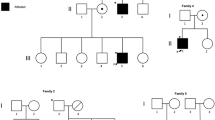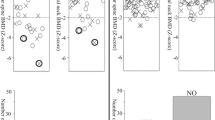Abstract
Summary
We identified a novel large fragment deletion from intron 9 to 3’UTR in PLS3 (E10-E16del) in one Chinese boy with X-linked early-onset osteoporosis and vertebral fractures, which expanded the pathogenic spectrum of X-linked early-onset osteoporosis. Treatment with zoledronic acid was beneficial for increasing BMD and reshaping the vertebral bodies of this patient.
Introduction
X-linked early-onset osteoporosis is a rare disease, which is characterized by low bone mineral density (BMD), vertebral compression fractures (VCFs), and/or long bone fractures. We aimed to detect the phenotype and the underlying pathogenic mutation of X-linked early-onset osteoporosis in a boy from a nonconsanguineous Chinese family.
Methods
We investigated the pathogenic mutation of the patient with X-linked early-onset osteoporosis by targeted next-generation sequencing and confirmed it by Sanger sequencing. We also observed the effects of zoledronic acid on fracture frequency and BMD of the patient.
Results
Low BMD and multiple VCFs were the main phenotypes of X-linked early-onset osteoporosis. We identified a total of 12,229 bp deletion in PLS3, involving intron 9 to the 3’UTR (E10-E16 del). This large fragment deletion might be mediated by Alu repeats and microhomology of 26 bp at each breakpoint junction. Zoledronic acid treatment could significantly increase the Z-score of BMD and reshape the compressed vertebral bodies.
Conclusion
We identified a large fragment deletion mutation in PLS3 for the first time and elucidated the possible mechanism of the deletion, which led to X-linked early-onset osteoporosis and multiple vertebral fractures. Our findings would enrich the etiology spectrum of this rare disease.



Similar content being viewed by others
References
van Dijk FS, Zillikens MC, Micha D (2013) PLS3 mutations in X-linked osteoporosis with fractures. N Engl J Med 369:1529–1536
Fahiminiya S, Majewski J, Al-Jallad H (2014) Osteoporosis caused by mutations in PLS3: clinical and bone tissue characteristics. J Bone Miner Res 29:1805–1814
Laine CM, Wessman M, Toiviainen-Salo S (2015) A novel splice mutation in PLS3 causes X-linked early onset low-turnover osteoporosis. J Bone Miner Res 30:510–518
Nishi E, Masuda K, Arakawa M (2016) Exome sequencing-based identification of mutations in non-syndromic genes among individuals with apparently syndromic features. Am J Med Genet A 170:2889–2894
van de Laarschot DM, Zillikens MC (2016) Atypical femur fracture in an adolescent boy treated with bisphosphonates for X-linked osteoporosis based on PLS3 mutation. Bone 91:148–151
Delanote V, Vandekerckhove J, Gettemans J (2005) Plastins: versatile modulators of actin organization in (patho) physiological cellular processes. Acta Pharmacol Sin 26:769–779
Klein MG, Shi W, Ramagopal U (2004) Structure of the actin crosslinking core of fimbrin. Structure 12:999–1013
Tanaka-Kamioka K, Kamioka H, Ris H (1998) Osteocyte shape is dependent on actin filaments and osteocyte processes are unique actin-rich projections. J Bone Miner Res 13:1555–1568
Atkins GJ, Findlay DM (2012) Osteocyte regulation of bone mineral: a little give and take. Osteoporos Int 23:2067–2079
Khadilkar AV, Sanwalka NJ, Chiplonkar SA (2011) Normative data and percentile curves for Dual Energy X-ray Absorptiometry in healthy Indian girls and boys aged 5–17 years. Bone 48:810–819
Li H, Ji CY, Zong XN (2009) Height and weight standardized growth charts for Chinese children and adolescents aged 0 to 18 years. Zhonghua Er Ke Za Zhi 47:487–492 [Chinese]
Milner GR, Levick RK, Kay R (1986) Assessment of bone age: a comparison of the Greulich and Pyle, and the Tanner and Whitehouse methods. Clin Radiol 37:119–121
Makitie O, Doria AS, Henriques F (2005) Radiographic vertebral morphology: a diagnostic tool in pediatric osteoporosis. J Pediatr 146:395–401
Forlino A, Marini JC (2016) Osteogenesis imperfecta. Lancet 387:1657–1671
Fahiminiya S, Majewski J, Roughley P (2013) Whole-exome sequencing reveals a heterozygous LRP5 mutation in a 6-year-old boy with vertebral compression fractures and low trabecular bone density. Bone 57:41–46
Korvala J, Juppner H, Makitie O (2012) Mutations in LRP5 cause primary osteoporosis without features of OI by reducing Wnt signaling activity. BMC Med Genet 13:26
Lv F, Xu XJ, Wang JY (2016) Two novel mutations in TMEM38B result in rare autosomal recessive osteogenesis imperfecta. J Hum Genet 61:539–545
Cho SY, Law CY, Ng KL (2016) Novel large deletion in AVPR2 gene causing copy number variation in a patient with X-linked nephrogenic diabetes insipidus. Clin Chim Acta 455:84–86
Benson G (1999) Tandem repeats finder: a program to analyze DNA sequences. Nucleic Acids Res 27:573–580
Froyen G, Belet S, Martinez F (2012) Copy-number gains of huwe1 due to replication- and recombination-based rearrangements. Am J Hum Genet 91:252–264
Shaw CJ, Lupski JR (2004) Implications of human genome architecture for rearrangement-based disorders: the genomic basis of disease. Hum Mol Genet 13 Spec No 1:R57-64
Ottaviani D, LeCain M, Sheer D (2014) The role of microhomology in genomic structural variation. Trends Genet 30:85–94
Hastings PJ, Ira G, Lupski JR (2009) A microhomology-mediated break-induced replication model for the origin of human copy number variation. PLoS Genet 5:e1000327
Li M, Lv F, Zhang Z (2016) Establishment of a normal reference value of parathyroid hormone in a large healthy Chinese population and evaluation of its relation to bone turnover and bone mineral density. Osteoporos Int 27:1907–1916
Rochefort GY, Pallu S, Benhamou CL (2010) Osteocyte: the unrecognized side of bone tissue. Osteoporos Int 21:1457–1469
Reddy R, Nguyen NM, Sarrabay G (2016) The genomic architecture of NLRP7 is Alu rich and predisposes to disease-associated large deletions. Eur J Hum Genet 24:1445–1452
Lyon AN, Pineda RH, Hao le T (2014) Calcium binding is essential for plastin 3 function in Smn-deficient motoneurons. Hum Mol Genet 23:1990–2004
Bishop N, Adami S, Ahmed SF (2013) Risedronate in children with osteogenesis imperfecta: a randomised, double-blind, placebo-controlled trial. Lancet 382:1424–1432
Baroncelli GI, Vierucci F, Bertelloni S (2013) Pamidronate treatment stimulates the onset of recovery phase reducing fracture rate and skeletal deformities in patients with idiopathic juvenile osteoporosis: comparison with untreated patients. J Bone Miner Metab 31:533–543
Dwan K, Phillipi CA, Steiner RD (2016) Bisphosphonate therapy for osteogenesis imperfecta. Cochrane Database Syst Rev 10:CD005088
Trejo P, Rauch F (2016) Osteogenesis imperfecta in children and adolescents—new developments in diagnosis and treatment. Osteoporos Int 27:3427–3437
Palomo T, Fassier F, Ouellet J (2015) Intravenous bisphosphonate therapy of young children with osteogenesis imperfecta: skeletal findings during follow up throughout the growing years. J Bone Miner Res 30:2150–2157
Land C, Rauch F, Munns CF (2006) Vertebral morphometry in children and adolescents with osteogenesis imperfecta: effect of intravenous pamidronate treatment. Bone 39:901–906
Acknowledgments
This study was supported by the National Natural Science Foundation of China (No. 81570802), National Key Research and Development Program of China (No. 2016YFC0901501), and CAMS Initiative for Innovative Medicine (2016-I2M-3-003). We thank the staff in the department of radiology department for measurement of bone mineral density and interpretation of X-ray films. We also thank the boy with PLS3 mutation and his family members for participation in this research. We thank all unaffected, unrelated individuals for providing control DNA samples.
Author information
Authors and Affiliations
Corresponding authors
Ethics declarations
Conflicts of interest
None.
Rights and permissions
About this article
Cite this article
Lv, F., Ma, M., Liu, W. et al. A novel large fragment deletion in PLS3 causes rare X-linked early-onset osteoporosis and response to zoledronic acid. Osteoporos Int 28, 2691–2700 (2017). https://doi.org/10.1007/s00198-017-4094-0
Received:
Accepted:
Published:
Issue Date:
DOI: https://doi.org/10.1007/s00198-017-4094-0




